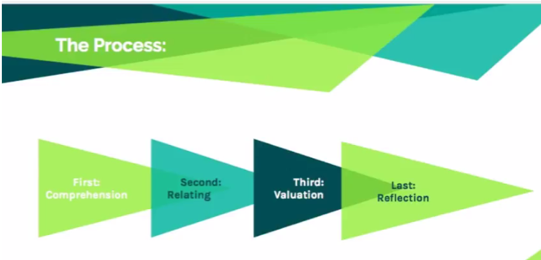A Review of Intra-Act Reading Strategy
by Irfan Rifai
Intra-Act is a reading technique that is aimed to develop readers’ ability to generate personal values or views of the world by using the selected text they read. It is a post-reading activity done in a group of 4-6 students. According to Hoffman (1979), the Intra-Act process has four phases: Comprehension Phase, Relational Phase, Valuation Phase , and Reflection Phase. In comprehension phase, students construct meaning from a text that offers differing viewpoints. At this stage, students read and summarize as groups. And then, they try to relate what they have learned about the topic with other text and prior experiences (relational phase) by reacting to or connecting with their own experiences. In valuation phase, students value their own and friends’ judgments about the topic. In the end, during reflective phase, students reflect on the decisions they have made. Some websites have claimed that the activity improve “students’ engagement and evaluative thinking, or value-based reasoning.” The fact that is done in groups, it is believed that the activity would also improve students’ ability in collaborative problem solving.
The Intra-Act Process diagram by Bellomy, C. From : https://www.youtube.com/watch?v=6W3Yk9gMrqU
The diagram shows that the activity emphasizes on students’ connection with their previous knowledge (schema), evaluation of the texts and peers’ opinions, analysis between opinions and facts, and on the sharing ( communicating) of those experiences. However, it does not mean that during the four phases, the other thinking skills are not incorporated. For example, at the relating stage, a group leader could initiate with questions that would intrigue her members of the group. A simple question like, “what is your reaction on the reading?” may trigger a flow of discussion or the start to textual analysis. At the final phase, students could infer or draw conclusions from their discussions.
The references I cite, unfortunately, did not specifically mentioned the significance of balancing the texts in its selection (of text). Instead, with the objectives of generating students’ past and current knowledge on certain topic and to get them to share and discuss in group, it focuses on “a reading selection on a controversial topic”. Students seem to focus on the chosen text and are not given the opportunity to choose their own texts during relating phase. With such objective, it does not mean that the opportunity to balance the literacy or the selection of the texts is not possible. Controversial topics are ever present in many forms of texts: popular texts like magazines, academics, videos, or even song lyrics. I think teachers are abundant with choices in providing a balanced texts when incorporating Inter-Act strategy.
By having students of different background knowledge to read the same text, then predict their friends’ opinions on some of the central points of the texts, and eventually share these differing values, I think all types of students would benefit from the experience. The strategy seems to value students’ personal reactions and past life(or reading) experience with the topic as well as training them to make logical conclusions(when working in group at the final stage) and predictions( when predicting their friend’ values) based on their own judgement of their knowledge about their friends. Besides, students would also be trained to confirm their findings (value their own judgment) by sharing their predictions to the groups. Even when the activity does not primarily target the passing of standardized test, these skills would definitely help students in working with the standardized tests. I would rate this activity with a 7.5. I like the facts that the activity incorporates a number of thinking strategies with the opportunity for students to improve their social skills. I think this procedure will work wonderfully well for college students too.
References
Bellomy, C . (2016). Intra-Act Reading Comprehension Strategy. Retrieved July 22, 2016 from https://www.youtube.com/watch?v=6W3Yk9gMrqU
Intra-Act. ( 2007). Retrieved July 21, 2016 from http://literacy.kent.edu/eureka/strategies/intra-act.pdf
Mitchell, K.S. (2005). Intra-Act reading activity . Retrived July 22, 2016 from http://novelinks.org/uploads/Novels/Night/Intra-Act%20reading%20activity.pdf
Reading Educator. (n.d.). Retrieved July 21, 2016, from http://www.readingeducator.com/strategies/intra.htm

Comments :